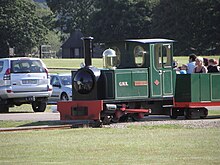
The San Diego Zoo Safari Park, originally named the San Diego Wild Animal Park until 2010, is an 1800-acre zoo in the San Pasqual Valley area of San Diego, California, near Escondido. It is one of the largest tourist attractions in San Diego County. The park houses a large array of wild and endangered animals from every continent, except Antarctica; this includes the largest, most comprehensive collection of hoofed mammals (ungulates) in the world. The park is in a semi-arid environment, about 30 miles (48 km) inland from the Pacific Ocean, giving it a year-round ‘feeling’ of being in Africa, with one of its most notable attractions being the Africa Tram, a half-hour guided tram ride which showcases the expansive ‘grassland’ exhibits. These free-range enclosures house the majority of the park's larger species, such as numerous antelopes, giraffes, buffalo, cranes, and rhinoceros, among others. The park is also noted for its California condor breeding program. When booked in-advance, the park also offers several longer, more in-depth safari options, some of which involve riding in an open-top truck to feed the animals in the field enclosures.
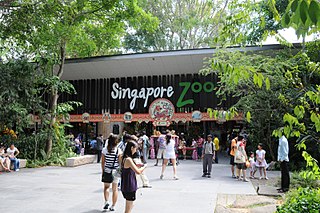
The Singapore Zoo, formerly known as the Singapore Zoological Gardens or Mandai Zoo, is a 28 hectares zoo located on the margins of Upper Seletar Reservoir within Singapore's heavily forested central catchment area. It is operated by the Mandai Wildlife Group, which also manages the neighbouring Night Safari, River Wonders, Bird Paradise as well as the forthcoming Rainforest Wild Park.

Whipsnade Zoo, formerly known as ZSL Whipsnade Zoo and Whipsnade Wild Animal Park, is a zoo and safari park located at Whipsnade, near Dunstable in Bedfordshire, England. It is one of two zoos that are owned by the Zoological Society of London (ZSL), a charity devoted to the worldwide conservation of animals and their habitats.
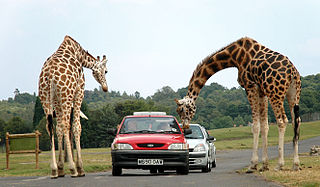
West Midlands Safari Park is a safari park located in Bewdley in Worcestershire, England. It was opened under the name of West Midland Safari Park in Spring 1973.
Port Lympne Hotel & Reserve near the town of Hythe in Kent, England is set in 600 acres (2.4 km2) and incorporates the historic Port Lympne Mansion, and landscaped gardens designed by architect Sir Herbert Baker, for Sir Philip Sassoon.

Colchester Zoo is a zoological garden situated near Colchester, England. The zoo opened in 1963 and celebrated its 60th anniversary on 2 June 2023. It is home to many rare and endangered species, including big cats, primates and birds as well as many invertebrates and fish species.

Knowsley Safari is a safari park and tourist attraction near Prescot, England. It is a member of the British and Irish Association of Zoos and Aquariums (BIAZA) and the European Association of Zoos and Aquaria (EAZA). It contributes to conservation and research through links with conservation projects and its links with universities in nearby Liverpool, as well as Chester and Manchester.

Edinburgh Zoo, formerly the Scottish National Zoological Park, is an 82-acre (33 ha) non-profit zoological park in the Corstorphine area of Edinburgh, Scotland.
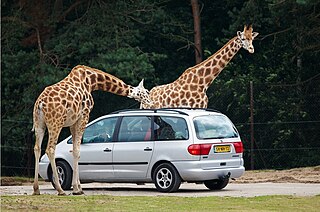
A safari park, sometimes known as a wildlife park, is a zoo-like commercial drive-in tourist attraction where visitors can drive their own vehicles or ride in vehicles provided by the facility to observe freely roaming animals.
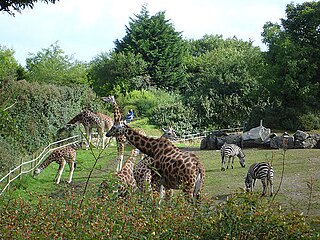
Belfast Zoological Gardens is a zoo in Belfast, Northern Ireland. It is in a relatively secluded location on the northeastern slope of Cavehill, overlooking Belfast's Antrim Road. Opened in 1934, it is the second-oldest zoo in Ireland, after Dublin Zoo, which opened in 1831.

Blair Drummond Safari Park is a family visitor attraction located near Stirling in Scotland. It opened to the public on 15 May 1970 and is home to over 350 animals, many of which roam freely or are kept in large enclosures in the 120-acre (49 ha) estate. The Safari Park is open from mid March until the end of December each year.
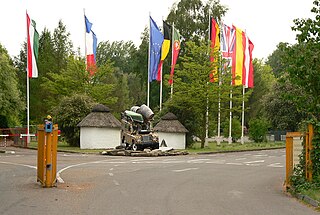
The Serengeti-Park in Hodenhagen, Lower Saxony, is a zoo and leisure park in North Germany.

The Bratislava Zoo is a zoo in Bratislava, Slovakia. It is located in the area of Mlynská dolina in the borough Karlova Ves. Opened in 1960, it is the second oldest zoo in Slovakia. The zoo covers an area of 96 hectares, out of which 35 hectares is open to the public. The zoo receives on average around 300,000 visitors annually.
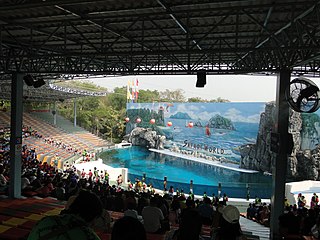
Safari World is a tourist attraction in Bangkok, Thailand that consists of two parks named Marine Park and Safari Park, operated by Safari World Public Limited. The park was opened in 1988 with a total area of 480 acres (190 ha) for its open zoo and 180 acres (73 ha) for its bird park. A major renovation to enhance effectiveness of land use began on 17 April 1989 and its total area developed for the leisure park now consists of an open zoo and a marine park on 500 rai of land.

Metro Richmond Zoo is a privately owned, for-profit zoo in Chesterfield County, Virginia. It is located in the central Virginia area, off of U.S. Route 360, about 20 miles southwest of Richmond. Metro Richmond Zoo encompasses about 70 acres (28 ha) and houses around 2,000 animals representing over 190 species, including reticulated giraffe, white rhinoceros, snow leopard, cheetah and Grant's zebra.

Africa Alive! Zoological Reserve, formerly known as Africa Alive! and Suffolk Wildlife Park, is a zoo located in Kessingland, Suffolk, UK. It is situated off the A12 at Kessingland 2 miles (3 km) south of Lowestoft.

Banham Zoological Gardens is a 50-acre (20 ha) zoo in Banham, Norfolk, England. The zoo itself, which today is home to more than 2,000 animals, opened to the public in 1968, became a charity in 2013, and has since been often awarded the prize of Norfolk's Top Attraction, by numerous different organisations, with an annual visitor attendance of in excess of 200,000 people. It is part of the Zoological Society of East Anglia, a registered charity which also owns Africa Alive Zoological Reserve near Lowestoft, Suffolk.
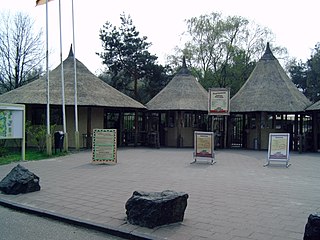
Safaripark Beekse Bergen is the largest wildlife zoo of the Benelux region and provides a home to approximately 1,250 animals from over 150 species, varying from small mammals to large birds. It is located between the cities of Tilburg and Hilvarenbeek in the south of the Netherlands. The visitors can for instance watch zebras and giraffes on the spacious savannahs. Safaripark Beekse Bergen offers the possibility to explore the park on numerous safaris: walksafari, carsafari, bussafari and boatsafari.

The Yorkshire Wildlife Park is an amusement park, wildlife conservation and rehabilition centre and tourist attraction located in Branton, south-east of Doncaster, South Yorkshire, England. It opened in 2009 on the site of Brockholes Farm, a former riding school and petting zoo, and features 500 animals of 100 species. Yorkshire Wildlife Park is an official member of the British and Irish Association of Zoos and Aquariums (BIAZA) and the European Association of Zoos and Aquaria (EAZA).
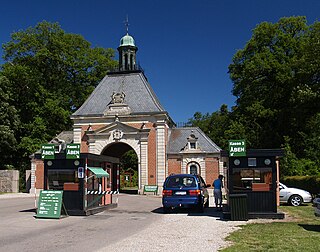
Knuthenborg Safaripark is a safari park on the island of Lolland in the southeast of Denmark. It is located 5 km (3.1 mi) to the north of Maribo, near Bandholm. It is one of Lolland's major tourist attractions with over 300,000 visitors annually, and is the largest safari park in northern Europe. Among others, it houses a drive-through safari park, a monkey forest, large enclosures for Siberian tigers and African bush elephants, a dinosaur forest with full-scale models, the Museum of Evolution with fossils of dinosaurs and other prehistoric animals, an arboretum, and the largest nature playground in Denmark. Knuthenborg covers a total of 660 hectares, including the 400-hectare (990-acre) Safaripark. The park is viewable on Google Street View.




